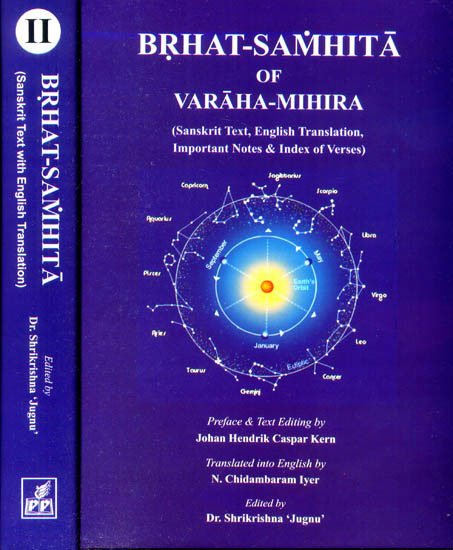Brihat Samhita
by N. Chidambaram Iyer | 1884 | 135,584 words | ISBN-13: 9788171104215
This page describes svati-yoga which is the twenty-fifth Chapter of the English translation of the Brihat-samhita. This work, written by Varahamihira in the 6th century, is classified as jyotisha literature, also known as Indian astronomy. It contains however, also content regarding astrology, palmistry, agriculture, gardening, perfumes, medicines and various other encyclopedic topics.
Chapter 25 - On Svāti-yoga
[Sanskrit text for this chapter is available]
Note: Svāti Yoga : This means the period of a day when the Moon passes through the asterism of Svāti in the month of Āṣāḍha.
1. All that has been said with respect to Rohṇī Yoga apply to both Svāti and Āṣādha Yogas;[1] but in the present chapter we shall only state certain special effects connected with Svāti Yoga.
2. Dividing both the day and night of the Svāti Yoga day each into three equal parts, if at night there should be a fall of rain during the first division, all the crops will flourish; if during the second division, gingelly, green gram and black gram will thrive and if during the third division, the crops of Grīṣma will thrive and those of Śarad will perish.
3. If there should be a fall of rain during the first division of the day, there will be abundant rain in winter; the same remark applies to the second and third divisions; but in these two cases worms and serpents will afflict mankind. If there should be a fall of rain throughout the day and night there will be uninterrupted rain for several days in winter.
4. To the due north of Citrā[2] there is a star known as Apāṃvatsa. If the moon should pass near it mankind will be happy.
5. If there should be a fall of snow on the dark night of the seventh lunar day of the dark half of the month of Māgha (January and February), or if a strong wind should blow or if dripping clouds should roar uninterruptedly or if there should be constant lightning or if the Sun, Moon and Stars should be wholly concealed by the clouds, mankind will be happy and crops will thrive.
6. The same remarks apply to the Svāti Yogas occurring in the months of Phālguna (Febrauary and March), Caitra (March and April) and Vaiśākha (April and May). But of the Svāti Yogas, that occurring in the month of Āṣāḍha (June and July) is the most important.
Footnotes and references:
[1]:
Vide chapter 26.
[2]:
At a distance of about 5°.
